-
Korean History Majors on the 2023 Spring Field Trip to GyeongjuAuthor : 관리자Date : 2023.06.19Hit : 227
-
Korean history major students and faculty members went on a spring field trip to Gyeongju for 3 days starting May 11th. A total of 67 people (54 undergraduates, 8 graduates, 4 professors, and 1 TA) participated in this trip.
The historic site field trip is an annual extracurricular program unique to the Department of Korean History, and it aims to help students bring their studies to life by experiencing the historical sites and seeing firsthand what they have learned from books.
This year’s historic site field trip took place in Gyeongju, a city with the thousand-year history of Silla. The students of the Department of Korean History saw firsthand the ruins and artifacts that showcase the thriving Buddhist culture of Silla, gained an in-depth understanding of the ancient Buddhist culture, and learned how Gyeongju changed and developed after the fall of Silla as it went through the Goryeo and Joseon dynasties.
▪ About the city and why it was chosen
Gyeongju was called “Seorabeol” or “Geumseong” during the Silla period and served as the capital city for 992 years. Later, after the Goryeo and Joseon dynasties, the city was renamed Gyeongju, and in modern times, it has been actively renovated and restored to become a tourist destination.
Since Gyeongju is known to have served as the capital of Silla for a thousand years, one can find many ruins and artifacts that showcase the Buddhist culture that flourished during the Silla period. The participants hoped to gain a deeper understanding of the ancient Buddhist culture by observing them. Another purpose of the field trip was to see how Gyeongju transformed and developed during the Goryeo and Joseon dynasties after the fall of Silla.
▪ Preparing for the spring field trip
The spring field trip was organized by a student-led trip planning committee. First, the pre-exploration team went on a pre-exploration itinerary for three days to check the appropriateness of the accommodation and itinerary. In order to ensure the safety of the trip, the team carefully examined the potential destinations and gathered useful information in advance to guarantee comfort during the actual trip. Later, the team published the pre-exploration report. It included an introduction to the artifacts and sites to be explored and solicited contributions from students on a variety of topics. The professors gave feedback on the content of the manuscripts and made sure the manuscripts were written in a scholarly manner.
▪ Spring field trip schedules
Day 1: Oksan Seowon, Jjoksaem Ruins Excavation Hall, Donggung Palace and Wolji Pond
Day 2: Bulguksa Temple, Gameunsa Temple Site, Tomb of Munmu of Silla, Golgulsa Temple, Girimsa Temple
Day 3: Namsan Mountain (Sambulsa Temple - Mangwolsa Temple - Stone Seated Buddha in Naenggok Valley - Rock-carved Avalokitesvara Bodhisattva in Samneunggyegok Valley - Rock-carved Buddha Triads in Samneunggyegok Valley - Rock-carved Seated Buddha in Samneunggyegok Valley - Samneung Royal Tombs)
- Oksan Seowon was a Confucian academy that was built to commemorate the academic achievements and virtues of Yi Eonjeok, a Confucian scholar and merchant from the early Joseon Dynasty. It is one of nine Korean Confucian academies on the UNESCO World Heritage List.
- Jjoksaem Ruins Excavation Hall is a public excavation site of the wooden chamber tombs with stone mounds, the most common tomb type from the Silla Dynasty in the 4th and 5th centuries.
- Donggung Palace and Wolji Pond, formerly known as Anapji, is a palace site from the Silla period.
- Bulguksa, Gameunsa, and Girimsa are temples from the Silla period found in texts such as "Samguksagi" and "Samgukyusa,” and Golgulsa is a stone cave temple with a legend that Great Master Wonhyo entered Nirvana.
- Namsan Mountain in Gyeongju is home to numerous Buddhist ruins and artifacts from the Silla period. During this field trip, the participants focused on the Samneunggyegok Valley in Namsan. Samneung Royal Tombs is believed to be the final resting place of the kings of the Park clan from the end of Silla.
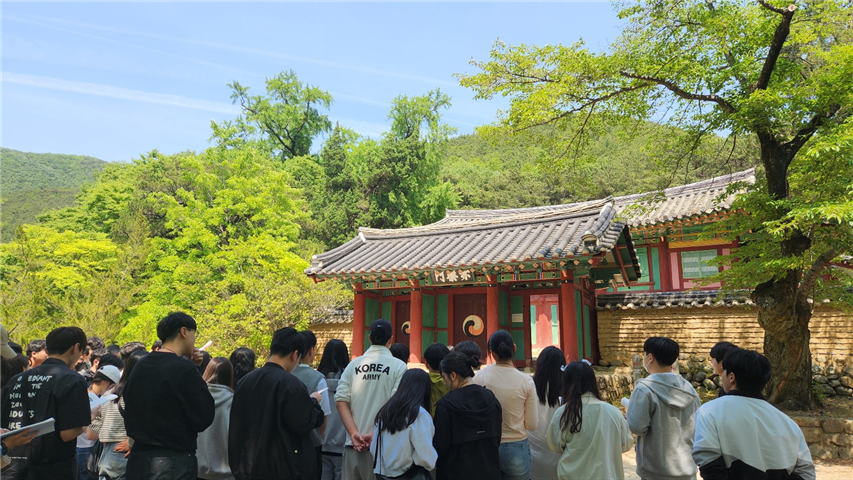
Day 1: Oksan Seowon (lecture by Prof. Huh Taekoo)
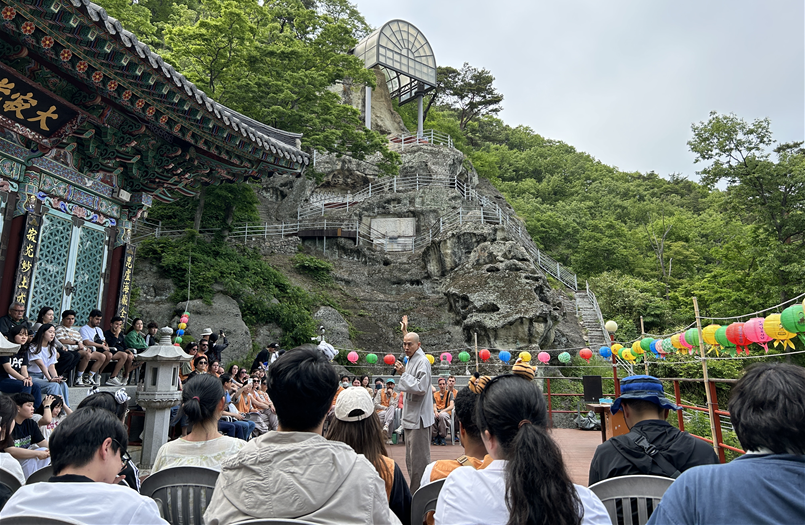
Day 2: Golgulsa Temple (lecture by a monk from the temple)
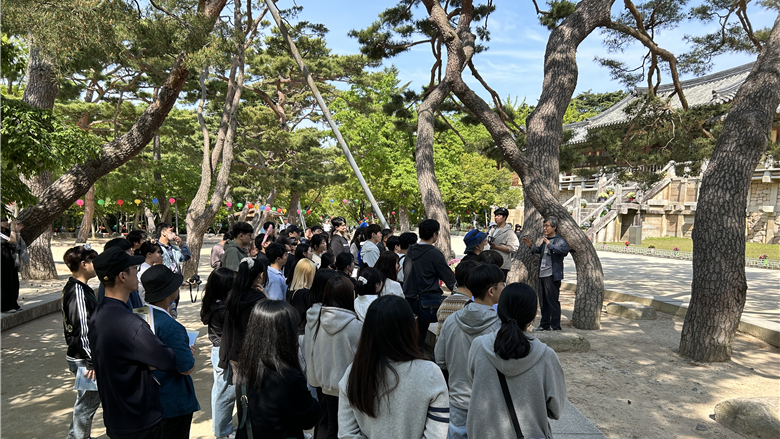
Day 2 (May 12): Bulguksa Temple (lecture by Prof. Jeong Yeontae)
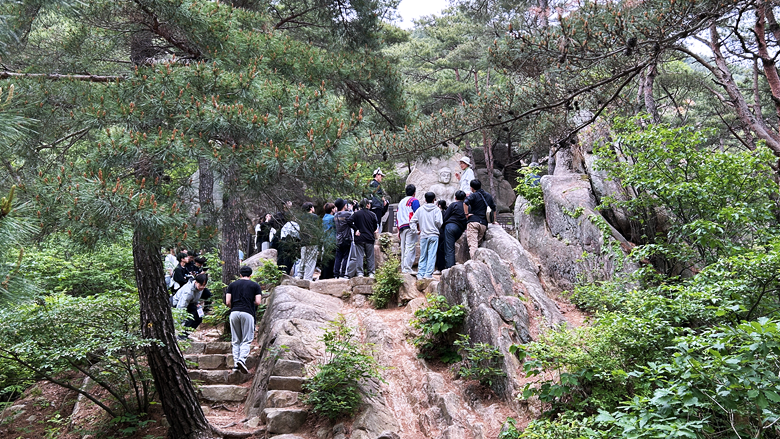
Day 3: Watching Buddha statues from Silla on Namsan in Gyeongju (lecture by Prof. Chae Woongseok)
▪ Course
For two days and three nights, the participants followed the pre-planned itinerary to explore the ruins and artifacts. At each site, the students learned about the site through professors' explanations as well as presentations and contributions from undergraduate and graduate students. The crossword puzzle event encouraged students to actively participate and learn.
On the evening of the second day, all students gathered at the auditorium for a festival. They took part in recreational activities, various games, and talent shows and solidified a sense of belonging and friendship. In addition, students were given the opportunity to ask professors for advice on academics and school life, and professors bonded with students.
▪ Testimony (Ki Kyoungryang, Head Professor of the Major in Korean History)
The historic site field trip is the most important event in the Department of Korean History that takes place each semester. Visiting historic places is a very important experience that brings history to life. However, the field trip could not be hosted starting in 2020 due to the pandemic. The Department of Korean History cautiously resumed the historic site field trips in the form of one-day trips in the spring semester of 2022, and it was not until the spring semester of 2023 that the usual three-day trips resumed.
Since the historic site field trip had been canceled for about three years, I was concerned that the know-how and tradition of preparing for the trip, which had been passed down from senior to junior, would be lost. Yet, the preparation committee worked more diligently to make the trip more successful than ever. The historic site field trip is an extracurricular program that is unique to the Department of Korean History. It is also an opportunity to explore historic sites across the country, through which one can sharpen his or her perspective and appreciation for history and cultural assets. Most importantly, the program is prepared and led by students. I hope we will be able to continue the tradition of fun and meaningful field trips in the future.
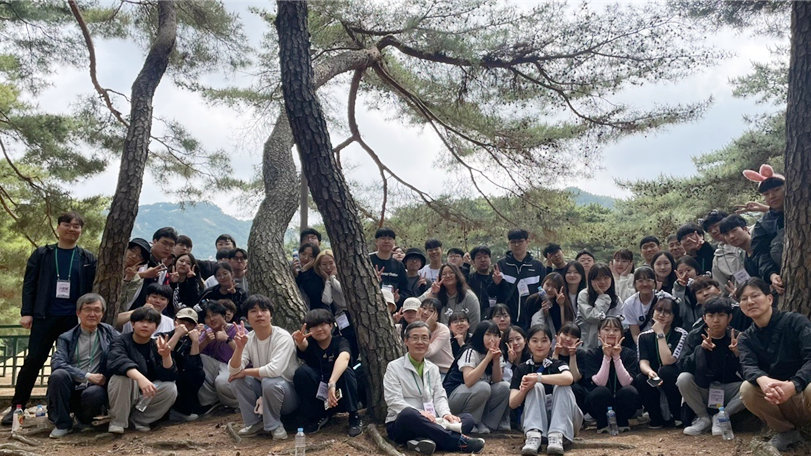
A group picture taken on Day 3 after the visit to Namsan Mountain in Gyeongju
-
Attachment File

